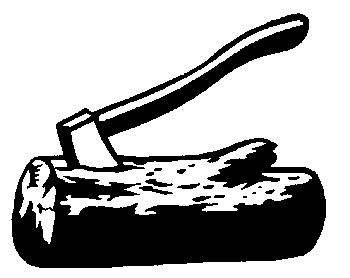
AXE AND LOG
SYMBOLISM
The Ax and Log symbol was designed on the first Wood Badge in 1919 by Francis Gidney to distinguish the Gilwell Organization and the Scout Organization.
Gidney was far from the idea that Gilwell Park should be the commercial or administrative center of Scouting. Rather, he sought to create a place in nature where Scouting took shape philosophically.
Scouts were taught that axes and knives buried in a log were safer in training given in Wood Badge courses.
Gidney was inspired by this and chose the ax and log as the totem of Gilwell Park.
This logo was strongly associated philosophically with Wood Badge leadership training and is still used today as a symbol of the Gilwell Training Method.
The ax symbol on the log is mainly from the period of feudalism after the invasion and conquest of England by William the Conqueror. At that time, property, including forests, belonged to landed barons and knights.
In a modified form of slavery, landed serfs were forbidden to cut wood from trees in the forest. They were only allowed to collect cut wood. When someone was seen carrying an ax in a nobleman's forest, it meant that he had earned his right by service.
Symbolically, the eye of an ax should be square. The handle should be trimmed accordingly. The steel head must be suitably tempered and kept sharp at all times.
A skilled user's ax is always balanced. Otherwise, the handle will break and endanger the user. The ax is the most valuable tool of a skilled lumberjack who has proven himself through service.
This symbolism from the era of feudalism was transferred to the Gilwell Method of Education in the early 1920s.
Those who complete this training today are considered committed to "service and loyalty."


Francis Gidney was the chief of the first WOOD BADGE course. He created the image of the Ax Billet. Philosophically, he also made great contributions to the Gilwell System.





